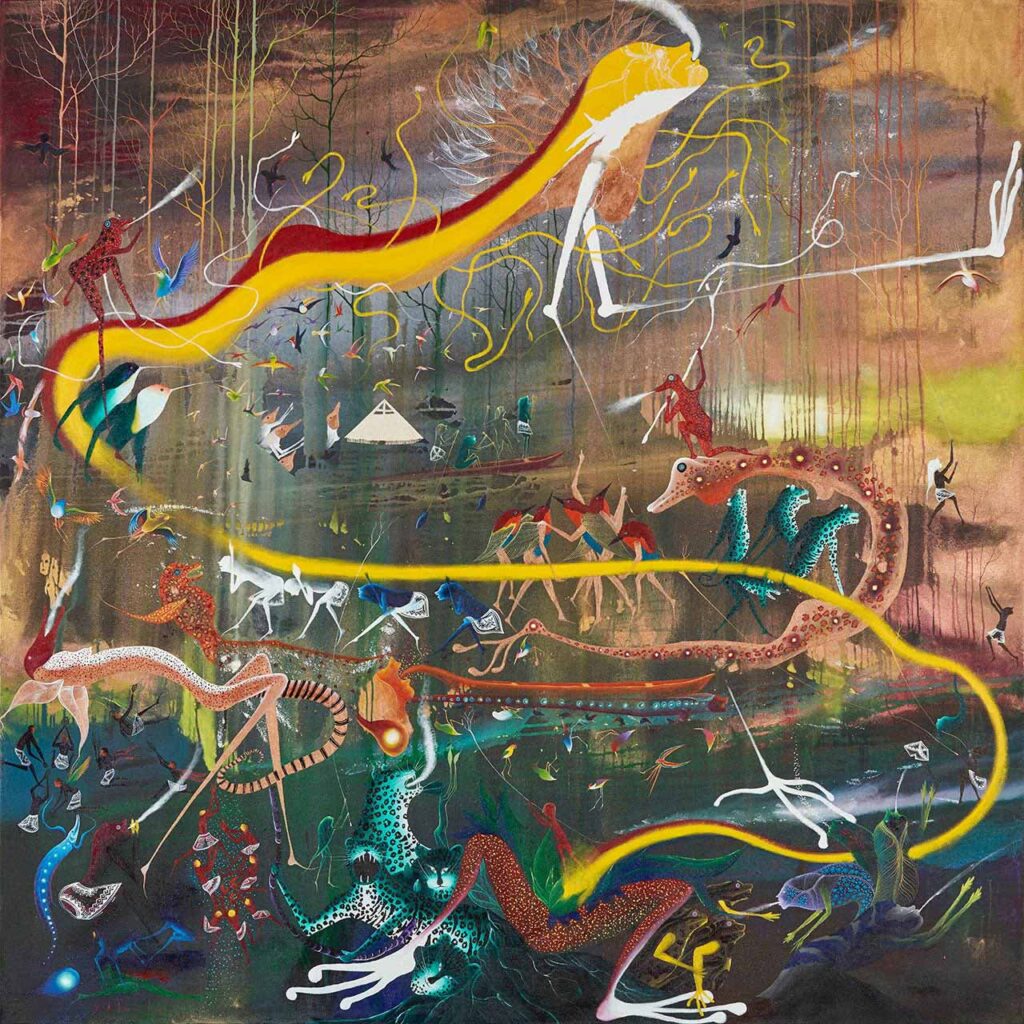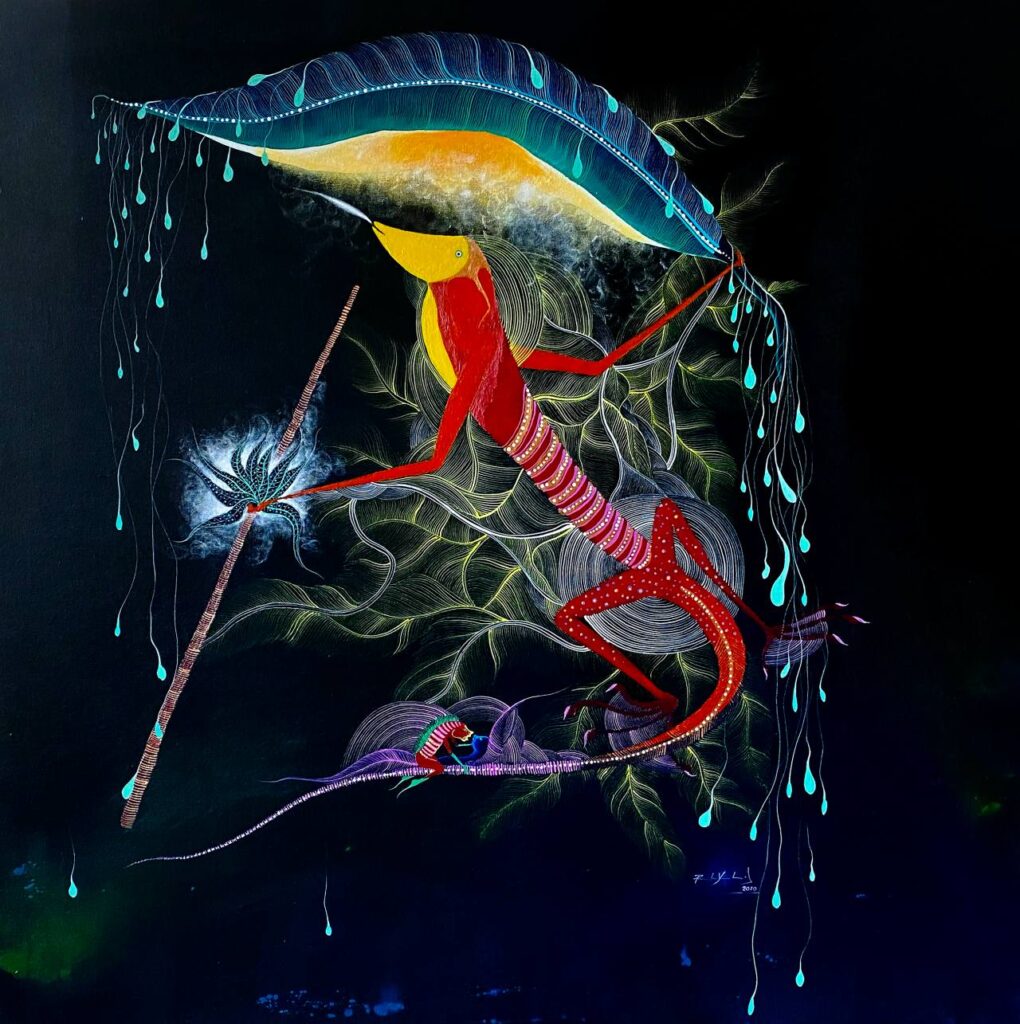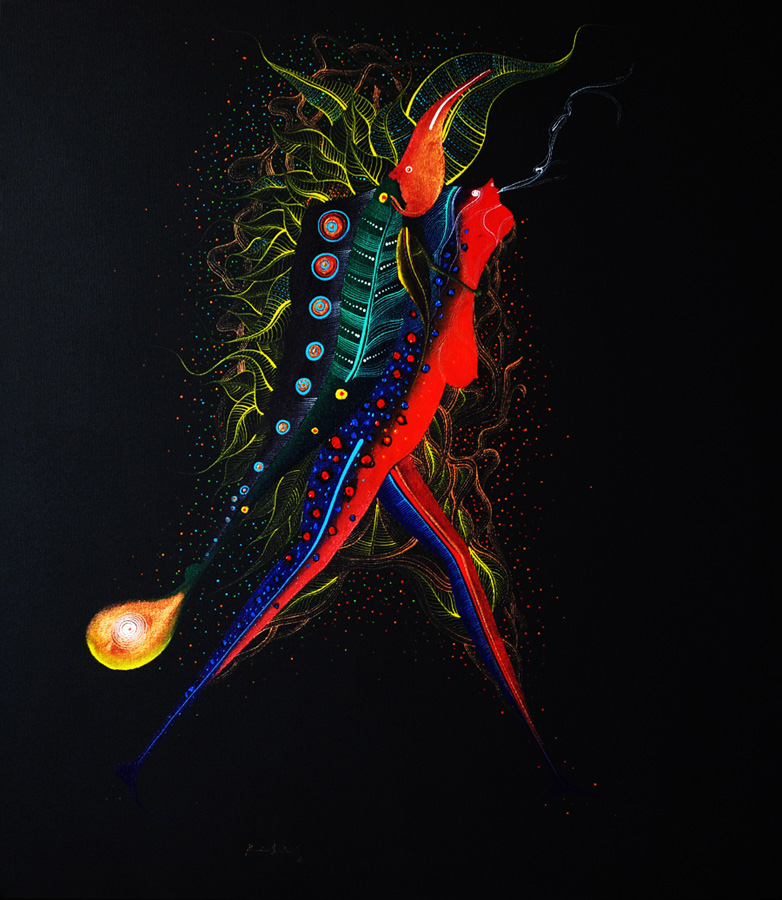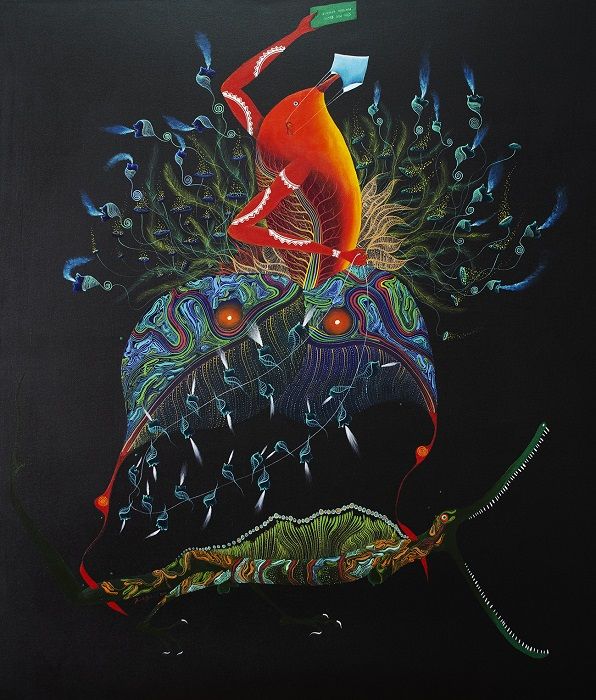
Rember Yahuarcani
The First Humans
2014
70 x 80 cm
Acrylic on canvas
In Uitoto mythology, all beings are understood to be one with the creator. All birds, fish, plants, and animals, are living forms through which the divine finds expression. The first humans were said to have emerged from the earth on a moonlit night. The unity of the figures as they walk together in harmony, indicates the tribalistic nature of early human societies. The anthropomorphic birds could allude to early humans being descendants of the first animal species that inhabited the earth. Prior to that first moment of creation, all beings are one in the same, existing within The Creator’s dream. That is the origin of life and what it means to be human. Humans are nature. We, too, come from that divine source.

Rember Yahuarcani
The first humans conquer the Rainbow Woman, they arrange her so that the sky does not fall to the earth
2017
170 x 170 cm
Acrylic and Llanchama on canvas
The elders describe a time, at the beginning of the world, when the earth and sky were united. The Creator called The Rainbow Woman to help him separate them. The Rainbow Woman lived at the edge of the world, and she refused to help the creator. The Creator, in his wrath, called his best warrior and entrusted him with the difficult task of bringing the Rainbow Woman to earth. The warrior turned his heart into a fruit and gave it to the Rainbow Woman. When she ate it, she fell into a deep sleep, and awoke to find that her body was spread out in many colors against the sky.

Rember Yahuarcani
Curacas of the Hummingbird Clan
2017
Acrylic on canvas
Curacas are intermediaries between the supernatural and mortal realms, between ethnic peoples and the Europeans that tried to eradicate them. They are depicted as part hummingbird, part human, transcending the boundary between bird and man. In their hands, they carry vines and trees, evocative of the ayahuasca plants native to the Amazon. The mushrooms that adorn their feet also speak to this psychedelic element. Curacas, animals, plants, are all powerful spiritual teachers, and indeed, they are one in the same.

Rember Yahuarcani
Cosmopolitan
2020
39 x 39 in
Acrylic on canvas
Rember shifts away from recording the myths of his people and paints his own creations. By blending different animals and elements of nature, he creates brand new characters brimming with life. He brings to life a hallucinated being from his imagination, using primordial elements such as smoke, light, and sperm-like rain. All life has a desire to survive. Rember said: “Man is cosmopolitan. He can adapt to any place. If a species does not adapt, it simply dies. I am no exception. Surviving in a space different from mine requires me to adopt new tools and ways of living, in this case new ways of expressing myself. My painting has evolved and has taken on new concepts. I don’t know whether to call it urban or contemporary, but in essence and identity it remains the same, which is what matters most.”

Rember Yahuarcani
Fish Woman
Acrylic on canvas
The zoomorphic spirit of a woman, treks underwater in the deep, dark sea. The breath of life courses through her, in and out of her mouth, supporting an entire ecosystem. The red and blue geometric pattern on the fish woman’s body creates a bejeweled effect. The fish creature on her back is her mate, attaching to her the way many male sea creatures do when it’s time to sexually reproduce. Male and female unite, becoming one form. Tiny orbs of light surround the form, representing the potential for new life, new worlds waiting to be created.

Rember Yahuarcani
Women’s Fish
2016
Acrylic on canvas
Uitoto teachings say that woman is a being emerged from the waters, allowing new generations to sprout. She unites life and death, and water, earth, and sky. The breath of life is a recurring theme in Rember’s paintings of divine feminine spirits. With each inhale and exhale, the female creatures of this work give life and light to the dark world that surrounds them. Even their hair, evocative of algae that grows on the surface of water, is a life-sustaining system that produces nourishment and oxygen for almost all plants and animals of the sea. These rich, creative spirits contain bioluminescence. An evolutionary trait that marine creatures developed over billions of years, giving them the ability to illuminate the dark.

Rember Yahuarcani
Untitled
2021
Acrylic on canvas
140 x 120 cm
A hallucinated being attempts to outrun death. But death is always lurking beneath the surface, intrinsically tied to life. The facemask covering the bird’s beak directly places this painting in the Covid-19 era. The object the creature holds in its hand could be a Vaccination Card or a boarding pass. Rember explains the impact Covid-19 had on Indigenous communities: “This pandemic has taken away several grandparents and that is a very regrettable loss for the Indigenous world. Grandparents are very valuable people for our culture because they have a wide and diverse knowledge that ranges from telling jokes, making antidotes, building houses, even walking through the woods where it is very easy to get lost. Instead of the Ministry of Culture recognizing these grandparents as deserving people, which does not entail any concrete benefit, what should exist is a comprehensive program that improves the quality of life of these people.”

Rember Yahuarcani
The Territory of the Grandparents
2021
140 x 170 cm
Acrylic on canvas
Rember Yahuarcani speaks out against the state of Peru, for its abhorrent treatment of people from the Amazon. From this lyrical narrative emerges a cold, sharp character waving the flag of Peru, and impaling one of the Uitoto gods, leaving chaos and destruction in its wake. It is a critique of the white supremacist systems responsible for the murder of Indigenous people and their culture. Fidoma, the boa god, coils around everything. There is a unity to it all, a harmony to the discord. The artist not only highlights the suffering, but also the resilience of life, the constant changes and adaptations that culture undertakes in order to survive. The “grandparents” are the gods, spirits, trees, birds, and fish scattered all around this cataclysmic landscape. They are the carriers of ancestral knowledge without whom the preservation of cultural stories would not be possible.


